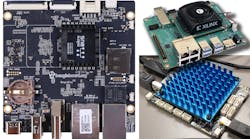What you’ll learn
- Why Bill is too busy to answer his email.
- What neat kits are available for developers?
I try to limit the number of development kits that roll by my workbench because I want to test them out and then write about them, or highlight the kits in our Kit Close-Up video series.
One common theme on the lab bench with these kits is artificial intelligence and machine learning (AI/ML). All have support for, and target applications that can utilize, AI/ML acceleration. They also can run Linux.
Right now, the stack is pretty high and I won’t get some of these up on our website for at least a couple weeks, but please check them out when they’re posted. In the meantime, here are a few that I think you might find useful, especially for robotic applications.
The NavQ+ is intended for the latest HoverGames competition (Fig. 1). Based on NXP’s i.MX 8M Plus, it can be paired with the new HoverGames buggy or the quadcopter. The focus of the latest challenge is to help Sustainable Food Ecosystems.
NavQ+ is designed to be the host process for the robots normally controlled by the RDDRONE-FMUK66 flight management unit (FMU), which can run Dronecode and PX4 Autopilot. The i.MX 8M Plus’s multicore Arm Cortex-A53 processors are linked to a neural processing unit (NPU). The NPU, which delivers up to 2.3 TOPS, is likely dealing with data from the dual image-signal-processing (ISP) units to handle video input. There’s a Cortex-M7 that can manage real-time chores with time-sensitive-networking (TSN) Ethernet support. The FMU and NavQ+ support single-pair Ethernet (SPE).
The AMD/Xilinx KR260 Robotics Starter Kit (Fig. 2) is built around the Kria K26 system-on-module (SOM), which contains a Zynq UItraScale+ MPSoC with an integrated FPGA. The processing sections includes multicore Arm Cortex-A53s and a dual-core Cortex-R5. The SOM can be configured to handle TSN and the carrier board exposes four Ethernet connections along with an SFP connection. There’s a hardware root of trust (RoT) with secure boot and TPM2.0 support.
This platform targets AI/ML applications with its FPGA support. Prototyping is supported with four Pmod connectors and a Raspberry Pi HAT header. There are four USB 3.0/2.0 interfaces as well.
NVIDIA’s Jetson Orin Nano Developer Kit (Fig. 3) fills out the high end of the low end. The compact module consumes less space and power than the Jetson AGX Orin. The Nano supports the Robot Operating System (ROS) 2, which also could be used in other platforms mentioned here. The GPU is built around 1,024 Ampere cores and 32 Tensor cores that deliver 40 TOPS while using 15 W of power. Six 64-bit Arm Cortex-A78AE cores also are in the mix.
The Jetson Orin Nano module is plug-compatible with other modules in the family, making it usable with a range of third-party carrier boards.
BeagleBone’s BeaglePlay, provided by Newark, is more than a plaything (Fig. 4). At its heart is Texas Instruments’ (TI) AM6254 that contains Arm Cortex-A53, Cortex-R5, Cortex-M4, and TI PRU cores. It supports Ethernet and SPE along with a host of interfaces including GROVE, QWIIC, CSI2, USB Type-A and Type-C, plus a mikroBUS header. It can even drive an HDMI display. On the wireless side, it supports sub-1-GHz IEEE 802.15.4 that can connect to a BeagleConnect Freedom up to 1 km away.
Again, for more insights on all sorts of kits, check out the Kit Close-Up videos when you get a chance.





